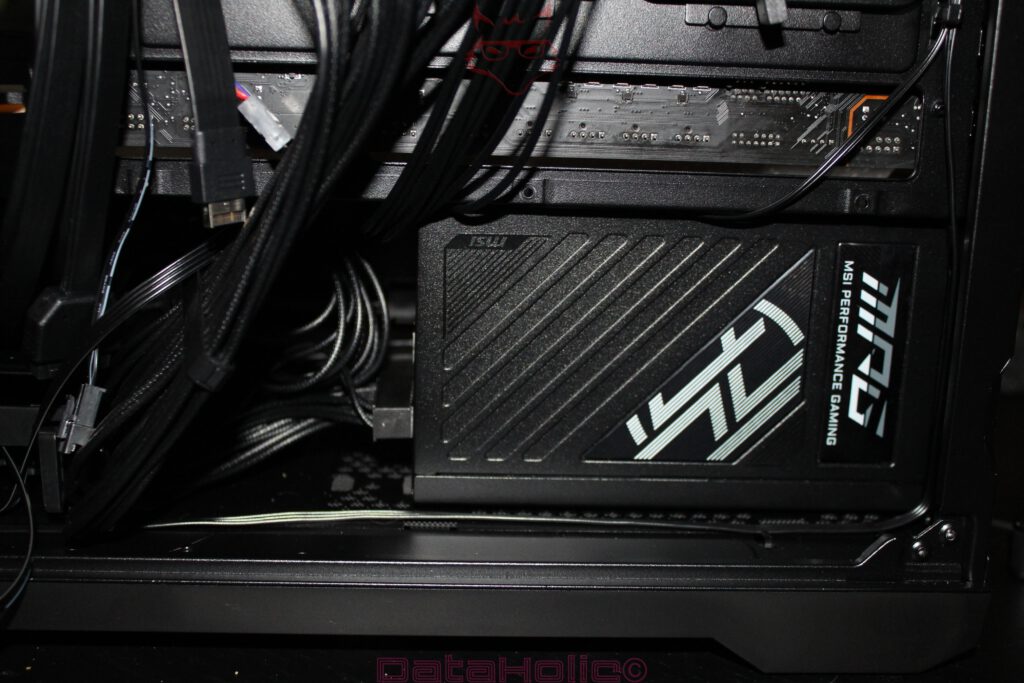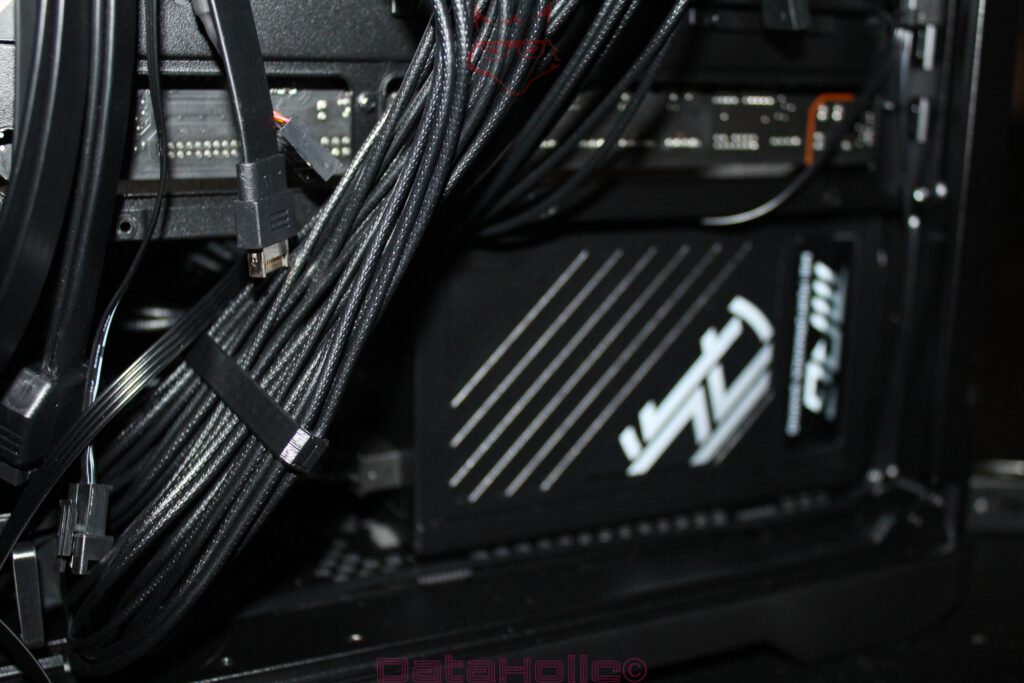Conclusion on the MSI MPG A1000GS PCIe5 – A Power Supply for the Present and the Future
- Introduction: More Than Just Power Delivery
- Technical Highlights at a Glance
- Test Hardware Configuration
- Connectivity: Bridging Future and Legacy
- Efficiency and Acoustics: A Silent Powerhouse
- Stability and Reliability Under Load
- Real-World Usage: Gaming, Work, Everyday Life
- Weak Points: Where There’s Light, There’s Shadow
- Personal Anecdote: Lessons Learned the Hard Way
- Conclusion: A PSU for Enthusiasts
- Transparency Note
Introduction: More Than Just Power Delivery
In the world of PCs, the power supply often plays the role of an unsung hero. While processors, graphics cards, and displays boast about dazzling performance numbers and glowing LEDs, the PSU stays in the background. Yet it is the component that decides not only about system stability and efficiency but also about its longevity. The MSI MPG A1000GS PCIe5 enters the stage with exactly this ambition: reliability, future-proofing, and a hint of MSI’s gaming DNA that permeates nearly all of their products.
A first glance at the specifications already makes clear: this unit is designed for the high end. With 1000 watts of total power output, support for ATX 3.1 and PCIe 5.1, and an array of connectors, it is positioned as the backbone for systems that aren’t just meant to shine today but to remain relevant in years to come.
But specifications on paper tell only half the story—real-world performance is where truth emerges. We tested the A1000GS PCIe5 with a current high-performance setup, looking closely at efficiency, noise, stability, and compatibility. In the end, the crucial question remains: is the MSI MPG A1000GS PCIe5 truly worth the investment?
Technical Highlights at a Glance
The PSU arrives in classic black, a minimalistic design but with MSI’s unmistakable performance-oriented styling. The centerpiece is its support for the new PCIe 5.1 power connector, crucial for today’s and tomorrow’s GPUs.
Table: Power Consumption in Practice
| Scenario | Power Draw (Watt) |
|---|---|
| Boot | 240.9 W |
| Idle | 190.6 W |
| Office | 232.2 W |
| Gaming | 395.4 W |
| Prime95 | 263.4 W |
| Furmark | 407.2 W |
| Prime95 & Furmark | 487.8 W |
| Off | 1.9 W |
Explanation of Results
- Boot: Short peaks during startup are typical; at ~241 W, the PSU handles it smoothly.
- Idle: With 190 W in standby operation, the system’s consumption is in line with expectations for a Ryzen 9 9900X and RTX 5070.
- Office: At 232 W under light workloads (browsing, productivity), efficiency is evident.
- Gaming: The most relevant real-world scenario: ~395 W draw during gameplay means the PSU runs far below its maximum capacity, ensuring quiet and efficient operation.
- Prime95: CPU stress only, consuming 263 W—stable, with no voltage dips.
- Furmark: GPU stress test, pulling 407 W. Well within safe operating headroom.
- Prime95 + Furmark: Both CPU and GPU maxed out simultaneously—487.8 W. The PSU still works below 50% of its rated output.
- Off: Even in shutdown state, 1.9 W remains—common for modern PCs but worth noting for energy purists.
Test Hardware Configuration
To ensure transparency and reproducibility, here is the exact test setup:
| Component | Manufacturer |
|---|---|
| Mainboard | MSI MPG B850 Edge TI WiFi |
| CPU | AMD Ryzen 9 9900X |
| RAM | Crucial Pro DDR5 32 GB (2×16) 6000 MHz |
| SSD | Kingston 2 TB PCIe4 NVMe M.2 |
| CPU Cooler | MSI MPG Coreliquid A15 360 |
| GPU | MSI GeForce RTX 5070 12G Ventus 3X OC |
| Power Supply | MSI MPG A1000GS PCIe5 |
| Tower | MSI MPG Pano 110R PZ |
| Display | LC-M34-Q-C-PRO |
| Keyboard | MSI Strike Pro Wireless |
| Mouse | MSI Versa Pro Wireless |
| Mousepad | MSI True Gaming |
This configuration represents a modern high-end gaming and productivity setup. Notably, the RTX 5070 relies on the 16-pin 12VHPWR connector, which this PSU provides natively. That makes it especially well-suited for current-generation GPUs.


Connectivity: Bridging Future and Legacy
One of the PSU’s strongest selling points is its wide connector support. Newer GPUs like the RTX 40/50 series are directly supported via native 16-pin cables. However, there’s a catch: for older models like the MSI RTX 3090 OC, the package lacks dedicated legacy cables. Users must rely on adapters, which function fine but detract from plug-and-play convenience.
This duality is important. For anyone building with cutting-edge hardware, the A1000GS PCIe5 is flawless. For those extending the life of older GPUs, a small adjustment is required.
Efficiency and Acoustics: A Silent Powerhouse
The 80 Plus Gold certification has long become standard in this wattage class, but MSI pushes further. Equipped with 100% Japanese 105°C capacitors and an optimized thermal design, the PSU not only maintains efficiency but also remains remarkably quiet.
Even under stress tests beyond 400 W, the cooling fan stayed barely audible. In gaming conditions, GPU noise easily masks it. Compared to power supplies from just a decade ago, where fans would often roar under load, the difference is like night and day.
As the Japanese saying goes: “The best technology is the one you don’t notice.” This fits the MSI MPG A1000GS PCIe5 perfectly.
Stability and Reliability Under Load
True PSU quality reveals itself not in the first hour of operation but after weeks and months. While our test period couldn’t cover long-term use, the build quality and measured results speak for themselves.
Voltage rails remained stable even under peak combined loads. This is critical because high-end hardware is sensitive to power fluctuations. Instability in a PSU can cause crashes, blue screens, or worse—damage to components.
Here, MSI’s choice of high-grade components clearly pays off.
Real-World Usage: Gaming, Work, Everyday Life
Gaming
With ~395 W during gaming, the PSU operates at its sweet spot—efficient, quiet, and with plenty of overhead for spikes. No stability issues arose even in extended sessions.
Creative Workloads
For productivity tasks like 3D rendering or video editing, stability is paramount. The A1000GS PCIe5 delivered consistent power delivery, making it a reliable choice for creators who push their systems to the limit.
Everyday Use
For browsing or office work, this PSU is admittedly overkill. But over-dimensioning here translates into efficiency, lower noise, and, most importantly, confidence in system stability.
Weak Points: Where There’s Light, There’s Shadow
No product is without flaws, and the MSI MPG A1000GS PCIe5 has a few minor shortcomings:
- Missing legacy GPU cables: Owners of older cards (RTX 3090, for example) must purchase or use adapters.
- Standby consumption: 1.9 W when off isn’t excessive, but it could be better.
- Price tag: Premium quality comes at a premium cost.
Personal Anecdote: Lessons Learned the Hard Way
Like many PC builders, my journey began with budget hardware. My very first PSU was a nameless “600 W” model bought for under €30. Two weeks later, it failed catastrophically—in a puff of smoke and a trip to the electronics recycler.
Since then, I’ve sworn never to cut corners on power supplies. The MSI MPG A1000GS PCIe5 is the complete opposite of that cheap disaster: it inspires trust. When powering an expensive high-performance system, that trust is worth more than any RGB lighting or flashy marketing claim.
Conclusion: A PSU for Enthusiasts
The MSI MPG A1000GS PCIe5 is a power supply built not only for today but also for the demands of tomorrow. With 1000 watts of total output, ATX 3.1 and PCIe 5.1 support, silent operation, and premium components, it’s the ideal choice for enthusiasts and professionals alike.
It excels in efficiency, reliability, and future-proofing, while only stumbling slightly in terms of backward compatibility and price. For builders of modern systems featuring GPUs like the RTX 5070, it’s a near-perfect solution.
Ultimately, a PSU is like the foundation of a house—you rarely see it, but everything relies on it. MSI has built a foundation in the MPG A1000GS PCIe5 that you can trust for years to come.
Transparency Note
In accordance with EU transparency regulations:
The MSI MPG A1000GS PCIe5 reviewed in this article was provided to us by MSI as a non-binding loan for testing purposes. This does not constitute paid promotion.
MSI had no influence on the content, evaluation, or editorial independence of this review. All opinions expressed are based solely on our practical experience.
We sincerely thank MSI for providing the PSU and for their trust in dataholic.de.
